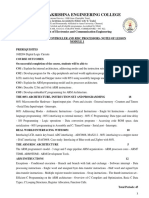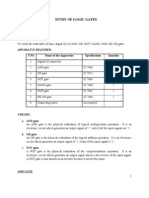0 ratings0% found this document useful (0 votes)
130 views18ec52 - DSP
18ec52 - DSP
Uploaded by
JEETHANThis document discusses digital signal processors and their hardware units. It explains that DSPs can use either von Neumann or Harvard architecture for their execution cycles. The main hardware units of a DSP are the multiplier and accumulator along with address generators. It also discusses fixed-point number format and how to convert decimal numbers to their two's complement binary representations in Q-15 format. An example shows converting the decimal -0.160123 to its Q-15 representation.
Copyright:
© All Rights Reserved
Available Formats
Download as PPTX, PDF, TXT or read online from Scribd
18ec52 - DSP
18ec52 - DSP
Uploaded by
JEETHAN0 ratings0% found this document useful (0 votes)
130 views14 pagesThis document discusses digital signal processors and their hardware units. It explains that DSPs can use either von Neumann or Harvard architecture for their execution cycles. The main hardware units of a DSP are the multiplier and accumulator along with address generators. It also discusses fixed-point number format and how to convert decimal numbers to their two's complement binary representations in Q-15 format. An example shows converting the decimal -0.160123 to its Q-15 representation.
Original Title
18EC52 - DSP.pptx
Copyright
© © All Rights Reserved
Available Formats
PPTX, PDF, TXT or read online from Scribd
Share this document
Did you find this document useful?
Is this content inappropriate?
This document discusses digital signal processors and their hardware units. It explains that DSPs can use either von Neumann or Harvard architecture for their execution cycles. The main hardware units of a DSP are the multiplier and accumulator along with address generators. It also discusses fixed-point number format and how to convert decimal numbers to their two's complement binary representations in Q-15 format. An example shows converting the decimal -0.160123 to its Q-15 representation.
Copyright:
© All Rights Reserved
Available Formats
Download as PPTX, PDF, TXT or read online from Scribd
Download as pptx, pdf, or txt
0 ratings0% found this document useful (0 votes)
130 views14 pages18ec52 - DSP
18ec52 - DSP
Uploaded by
JEETHANThis document discusses digital signal processors and their hardware units. It explains that DSPs can use either von Neumann or Harvard architecture for their execution cycles. The main hardware units of a DSP are the multiplier and accumulator along with address generators. It also discusses fixed-point number format and how to convert decimal numbers to their two's complement binary representations in Q-15 format. An example shows converting the decimal -0.160123 to its Q-15 representation.
Copyright:
© All Rights Reserved
Available Formats
Download as PPTX, PDF, TXT or read online from Scribd
Download as pptx, pdf, or txt
You are on page 1of 14
18EC52 - DSP
Digital Signal Processors
Von Neumann architecture
Harvard architecture.
Execution cycle based on the
Von Neumann architecture
Execution cycle based on
Harvard architecture
DIGITAL SIGNAL PROCESSOR
HARDWARE UNITS
• Multiplier and Accumulator
Address Generators
Fixed-Point Format
Converting a decimal number to its 2’s
complement form requires following steps:
1. Convert the magnitude in the decimal to its binary
number using the required number of bits.
2. If the decimal number is positive, its binary number is its
2’s complement representation; if the decimal number is
negative, perform the 2’s complement operation, where
we negate the binary number by changing the logic 1s to
logic 0s and logic 0s to logic 1s and then add a logic 1 to
the data.
Q – format
Q-15 means that the data are in a sign magnitude form in which
there are 15 bits for magnitude and one bit for sign.
Find the signed Q-15 representation for the decimal
number 0.560123.
Find the signed Q-15 representation for the
decimal number -0.160123
Converting the Q-15 format for the corresponding
positive number with the same magnitude using
the procedure
0:160123 =0:001010001111110
Then after applying 2’s complement, the Q-15
format becomes
-0:160123 = 1:110101110000010
You might also like
- 18ec61 DCDocument146 pages18ec61 DCSadashiv BalawadNo ratings yet
- One Step Majority DecoderDocument18 pagesOne Step Majority DecoderAkshay Doshi100% (1)
- 18MT57-MITE - 16 Laboratory Manual - Format - MITE - 16 - VI - 18MTL57Document31 pages18MT57-MITE - 16 Laboratory Manual - Format - MITE - 16 - VI - 18MTL57Gauthami ShettyNo ratings yet
- DSP Lab ManualDocument67 pagesDSP Lab Manualloststranger990100% (1)
- Module 1 NOTES (MED 18ES51) PDFDocument18 pagesModule 1 NOTES (MED 18ES51) PDFHarishNo ratings yet
- Generation and Detection of DPSKDocument3 pagesGeneration and Detection of DPSKAmy Oliver100% (1)
- Ece-Vii-dsp Algorithms & Architecture (10ec751) - AssignmentDocument9 pagesEce-Vii-dsp Algorithms & Architecture (10ec751) - AssignmentMuhammadMansoorGohar100% (1)
- Digital Voltmeter Using PIC MicrocontrollerDocument7 pagesDigital Voltmeter Using PIC MicrocontrollerbecemNo ratings yet
- RIC - 653 - Control Sys Lab-IDocument61 pagesRIC - 653 - Control Sys Lab-IVatsal MehrotraNo ratings yet
- MicroCont LabManual UpdatedDocument53 pagesMicroCont LabManual Updatedrishitej811No ratings yet
- Traffic Light Control SystemDocument21 pagesTraffic Light Control SystemabhisheksingjadonNo ratings yet
- Transform Coding IIDocument19 pagesTransform Coding IIRakesh InaniNo ratings yet
- Delta ModulationDocument9 pagesDelta ModulationRUTUJA GOGULWARNo ratings yet
- 6-A Prediction ProblemDocument31 pages6-A Prediction ProblemPrabhjot KhuranaNo ratings yet
- ECE (2022) 5th Sem SyllabusDocument31 pagesECE (2022) 5th Sem SyllabusYaman VermaNo ratings yet
- 18EC44 I IA - New PDFDocument1 page18EC44 I IA - New PDFGovind M RoddannavarNo ratings yet
- DSP (18EC52) Course File PlanningDocument7 pagesDSP (18EC52) Course File PlanningShravan KumarNo ratings yet
- Experiment No: 4: TITLE: 4-Bit Comparator AIM: To Design 4-Bit Comparator Using IC 7485 Prior ConceptDocument43 pagesExperiment No: 4: TITLE: 4-Bit Comparator AIM: To Design 4-Bit Comparator Using IC 7485 Prior ConceptKelvin CooperNo ratings yet
- 16x1 Mux Using 8x1 Mux and 2x1 MuxDocument3 pages16x1 Mux Using 8x1 Mux and 2x1 MuxAditya PNo ratings yet
- Unit 6 I ADCDocument29 pagesUnit 6 I ADCcacaNo ratings yet
- Analog and Digital Electronics Lab Manual (17CSL37) : Department of Computer Science and EngineeringDocument61 pagesAnalog and Digital Electronics Lab Manual (17CSL37) : Department of Computer Science and Engineeringvadla77No ratings yet
- Verilog HDL Module 1 NotesDocument29 pagesVerilog HDL Module 1 NotesAbdullah Gubbi100% (2)
- MultiSim PDFDocument5 pagesMultiSim PDFjaya1816No ratings yet
- ARM Lab Manual1 PDFDocument53 pagesARM Lab Manual1 PDFAravind RameshNo ratings yet
- Experiment 6 Implementation of LP Fir Filter For A Given SequenceDocument25 pagesExperiment 6 Implementation of LP Fir Filter For A Given SequenceSrinivas SamalNo ratings yet
- M.E.VLSI DesignDocument43 pagesM.E.VLSI DesignThahsin ThahirNo ratings yet
- MANUAL COMMUNICATION LAB-II, KEC-651,2020-21, Even SemDocument18 pagesMANUAL COMMUNICATION LAB-II, KEC-651,2020-21, Even SemPiyushNo ratings yet
- VLSI Ch4 DelayDocument27 pagesVLSI Ch4 Delayជើងកាង ភូមិNo ratings yet
- Ac+lic Lab Manual 2018-19Document76 pagesAc+lic Lab Manual 2018-19Samanvi SaatviNo ratings yet
- DSP Vtu Lab ManualDocument137 pagesDSP Vtu Lab Manualvivek jNo ratings yet
- Final C++ ManualDocument36 pagesFinal C++ ManualHarish G C100% (1)
- Clipper CircuitDocument4 pagesClipper CircuitMehedi Hasan100% (5)
- Optimum Detection of Binary PAM in Noise: PAM: Pulse Amplitude ModulationDocument9 pagesOptimum Detection of Binary PAM in Noise: PAM: Pulse Amplitude ModulationGeorges ChouchaniNo ratings yet
- DC Convolution CodesDocument136 pagesDC Convolution CodesARAVINDNo ratings yet
- Microcontroller Notes MODULE 1Document49 pagesMicrocontroller Notes MODULE 1Sri Janani100% (2)
- Lecture 7 (Channel Models For Mmwave MIMO System)Document65 pagesLecture 7 (Channel Models For Mmwave MIMO System)Kushagra PratapNo ratings yet
- Digital Electronics Laboratory Manual 17ECL38: Avalahalli, Doddaballapur Road Yelahanka, Bengaluru-560064Document51 pagesDigital Electronics Laboratory Manual 17ECL38: Avalahalli, Doddaballapur Road Yelahanka, Bengaluru-560064SANTOSH KUMAR SNo ratings yet
- Das SyllabusDocument2 pagesDas SyllabusHemanth Kumar100% (1)
- Pulse Possition Modulation - Lab AssignmentDocument8 pagesPulse Possition Modulation - Lab Assignmentsanamdeep kaur khangura100% (1)
- DSP Mod1@AzDOCUMENTS - inDocument60 pagesDSP Mod1@AzDOCUMENTS - inDeepa JerinNo ratings yet
- VHDL Introduction by J BhaskerDocument4 pagesVHDL Introduction by J BhaskerVishi Agrawal0% (1)
- Experiment no. 2 Aim: - Theory: c1 (t) = √2/Tb cos 2πƒ1tDocument6 pagesExperiment no. 2 Aim: - Theory: c1 (t) = √2/Tb cos 2πƒ1tMudit GoelNo ratings yet
- ECL333 - Ktu QbankDocument7 pagesECL333 - Ktu QbankRoshith KNo ratings yet
- Ece IV Microcontrollers (10es42) NotesDocument121 pagesEce IV Microcontrollers (10es42) NotesSoujanya Rao KNo ratings yet
- DLD - Ch.1 Notes PDFDocument35 pagesDLD - Ch.1 Notes PDFAlradi Malak FadiNo ratings yet
- Unit 5Document31 pagesUnit 5rajdattaNo ratings yet
- TELE9753 Tutorial 5Document4 pagesTELE9753 Tutorial 5Charles WangNo ratings yet
- Hardware Description LanguageDocument4 pagesHardware Description Languageduttbhuwan2020100% (1)
- PN Sequence GeneratorDocument55 pagesPN Sequence GeneratorVigyan Jain100% (1)
- VTU E&C CBCS Scheme 5th Sem Information Theory and Coding Module-2 NotesDocument110 pagesVTU E&C CBCS Scheme 5th Sem Information Theory and Coding Module-2 Notesjayanthdwijesh h p0% (1)
- PCM Noise and CompandingDocument15 pagesPCM Noise and Compandingwoody0No ratings yet
- Digital Communication Lab: Internal Lab Exam-QuestionsDocument4 pagesDigital Communication Lab: Internal Lab Exam-Questionsalwin9185No ratings yet
- DC Lab VivaDocument5 pagesDC Lab VivaAbir HoqueNo ratings yet
- DSP Lecture OneDocument5 pagesDSP Lecture OnelyalashwanyNo ratings yet
- Analog Electronics: Board of Technical Examinations, BengaluruDocument18 pagesAnalog Electronics: Board of Technical Examinations, BengaluruFawaz AhmedNo ratings yet
- Lic Lab MannualDocument103 pagesLic Lab MannualAnusha NatarajanNo ratings yet
- ADSD Fall2011 09 Fixed Point RepresentationDocument41 pagesADSD Fall2011 09 Fixed Point RepresentationRehan HafizNo ratings yet
- DSP Module 5Document24 pagesDSP Module 5shilpaNo ratings yet



























































